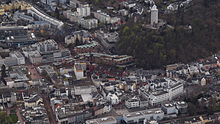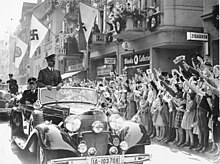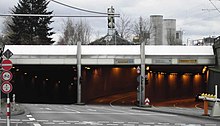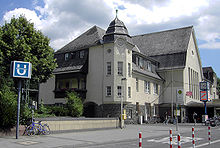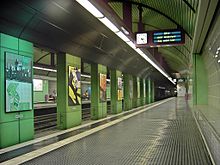bad Godesberg
|
Bad Godesberg district of Bonn |
|
|---|---|
| Coordinates | 50 ° 41 '5 " N , 7 ° 9' 18" E |
| height | 66 m (47.2– 181.6 m ) |
| area | 31.97 km² |
| Residents | 75,038 (Dec 2018) |
| Population density | 2347 inhabitants / km² |
| Incorporation | Aug 1, 1969 |
| Post Code | 53173, 53175, 53177, 53179 |
| prefix | 0228 |
Administration address |
Kurfürstenallee 1a 53177 Bonn |
| Website | bonn.de: Bad God-esberg |
| structure | |
| Structure of the city district |
13 districts |
| politics | |
| District Mayor | Christoph Jansen ( CDU ) |
| First Deputy District Mayor | Michael Wenzel ( Greens ) |
| Transport links | |
| Highway |
|
| Federal road |
|
| railroad | RB REMRB |
| Light rail | 16, 63 |
| bus | 610, 611, 612, 613, 614, 637, 638, 639, 852, 855, 856, 857 |

Bad Godesberg is one of the four districts of the federal city of Bonn and has 75,038 inhabitants (December 31, 2018). Bad Godesberg is located on the southern tip of the Cologne Bay in the Godesberg Rhine valley funnel and thus at the transition from the Middle to the Lower Rhine . The city district borders the state of Rhineland-Palatinate to the southeast .
structure
The following 13 districts are located within the Bad Godesberg district:
- Alt-Godesberg
- Friesdorf
- Godesberg-North
- Godesberg villa district
- Heiderhof
- Hochkreuz
- Lannesdorf
- Flour
- Muffendorf
- Pennenfeld
- Plittersdorf
- Rüngsdorf
- Schweinheim
In addition, there are 16 statistical districts , some of which differ only slightly in size and extent from the districts. In the area of the city district, the following districts exist within the boundaries of former communities: Friesdorf , Godesberg , Lannesdorf , Mehlem , Muffendorf , Plittersdorf and Rüngsdorf .
story
Until 1697
Godesberg was 722 ubische worship Woudensberg ( Wotan documented mountain). Godesberg gained importance in 1210 when the Cologne Elector and Archbishop Dietrich I von Hengebach laid the foundation stone for Godesburg on October 15th . On December 17, 1583, Godesburg was blown up by the troops of Elector Ernst von Bayern after his deposed predecessor Gebhard I von Waldburg Truchsess von Waldburg-Zeil had holed up there.
1697-1945
From 1697 to 1699, under Elector Joseph Clemens of Bavaria, the interior of the Michaelskapelle on Godesberg was furnished with a splendid baroque decoration , giving it its current appearance. From 1699 the chapel became the house church of the Order of Saint Michael founded a few years earlier . From 1790 to 1792, Elector Max Franz had the healing spring ( Draitschbrunnen ) redesigned, the spa park laid out and the redoubt and the 9 adjacent lodgings built. Godesberg became a seaside resort.
Wonderfully country belonged Godesberg until the end of the 18th century to the Electorate of Cologne and the administration was under the Office Godesberg-Mehlem in Oberamt Bonn . In 1816, Godesberg became the seat of the mayor's office of the same name in the Bonn district , which belonged to the Cologne administrative district in the later Rhine province .
With the construction of the railway line , the city finally became the summer and retirement home of wealthy citizens, which led to significant growth. In 1899 Plittersdorf and Rüngsdorf were incorporated, followed by Friesdorf in 1904 and Muffendorf in 1915 . In 1925 Godesberg was awarded the title Bad , which was recorded from October 1, 1926. With the incorporation of Lannesdorf and Mehlem , Bad Godesberg received city rights in 1935.
In the time of National Socialism Bad Godesberg gained the reputation of being a particularly popular place for the “Führer”. Adolf Hitler stayed on the Rhine 70 times between 1926 and 1945. His most spectacular performance took place here from September 22nd to 24th, 1938, when he met British Prime Minister Arthur Neville Chamberlain in Bad Godesberg to negotiate with him about the Sudeten crisis . During this visit, as on the occasion of previous visits, numerous Bad Godesberg citizens lined the streets to cheer Hitler on his journey from Godesberg city center to the Rheinhotel Dreesen .
1945 until today
Bad Godesberg survived the Second World War largely undestroyed: largely spared from the aerial warfare , the city was heavily occupied with wounded and old people. Therefore, Lieutenant General Richard Schimpf (1897–1972) decided, in consultation with some of the Godesberg citizens, to have the 7,000 men of his division cross the Rhine to the east on the night of March 8, 1945 and not to defend the city but to close it without a fight to hand over. Vice-mayor Heinrich Ditz handed over the city to the Americans by telephone after the Nazi mayor Heinrich Alefhad set down on the right bank of the Rhine. This made Bad Godesberg the first major city to fall into the hands of the Allies without a fight and undestroyed. A plaque on the Godesberg town hall commemorates the three decisive people who saved Bad Godesberg at risk of death: Lieutenant General Schimpf, City Councilor Ditz and the Swiss Consul General François-Rodolphe de Weiss .
After Bonn had become the provisional federal capital in 1949 , Bad Godesberg, which was largely undamaged during the war, became the seat of many embassies . Godesberg was nicknamed Diplomatic City , and the B 9 to Bonn became a diplomatic racecourse . The Maternus wine tavern near the train station, where Konrad Adenauer regularly ate lunch, was soon nicknamed the “ living room of the republic”, as numerous diplomatic negotiations were held there.
At the end of 1950 the decision was made to completely relocate the US High Commission to the Bonn enclave and to set up the headquarters in the Bad Godesberger Deichmannsaue . For this purpose, housing projects were initiated for the German employees of the commission, which resulted in the HICOG housing estate Muffendorf / Pennenfeld and the HICOG housing estate Plittersdorf in the then city of Bad Godesberg . Both settlements are now a listed building.
In 1959, the SPD chose the Godesberger Stadthalle, which had been opened four years earlier by the then Federal President Theodor Heuss , as the conference venue in order to implement the Godesberg program as a people 's party . The building is considered a striking example of the architectural style of the 1950s; it was placed under monument protection in July 2012.
Until 1981 Bad Godesberg was also the branch of the Federal Criminal Police Office .
Bad Godesberg was an independent town until August 1, 1969. A lawsuit against the incorporation to Bonn was unsuccessful. The city was represented before the administrative court of Münster by its city director Fritz Brüse (CDU) and 1st alderman Walter Viktor (SPD). The former Prime Minister of North Rhine-Westphalia, Franz Meyers , handled the merger of the city of Bonn with Bad Godesberg, Duisdorf and Beuel to form the new city of Bonn.
The commitments associated with the incorporation were sometimes redeemed very late. Bad Godesberg has only been supplied with drinking water from the Wahnbachtalsperre since 1989 ; before that, the quality of the filtrate on the banks of the Rhine was of poorer quality . Even the direct connection of the southernmost districts up to and including Mehlem by the original Bonn – Godesberg – Mehlem tram (BGM) was not achieved again with the construction of the new light rail , as it ends at the 'Stadthalle Bad Godesberg' station .
Today Bad Godesberg is a district of Bonn; he has preserved his independence in many ways. Most of the residents still feel like Godesbergers who go “to Bonn” for certain purchases. The district council has also been granted all rights that the municipal code of North Rhine-Westphalia allows.

On April 16, 2008, the Bad Godesberg district council decided to sell the Redoute and to advertise the row of houses in Kurfürstenallee as a "high-quality wellness hotel throughout Europe". In April 2008, a public petition entitled “Save the town hall and the redoubt” began to preserve the historic buildings owned by the city. The initiative for the referendum submitted 11,000 signatures in January 2009. In the time after German reunification and the move of the government to Berlin, Bad Godesberg developed into a district that in some places has the characteristics of a social hotspothaving. The number of serious violent crimes increased significantly in 2011 compared to previous years. The rugged juxtaposition of the residential area and the problem area has become a characteristic of Bad Godesberg in recent years. In 2012, in the face of a counter-demonstration by Salafists against a rally by PRO-NRW supporters, there were serious attacks on police officers by Salafists.
Coat of arms, flag and banner
| Banner, coat of arms and flag | |

|

|

|
|
Blazon: “In red over green Dreiberg, a three-tower, crenellated golden castle with an open portcullis; on the raised central tower a silver shield with a black cross bar through it. "
The coat of arms shows a three-part representation of the Godesburg on a red background, elevated in the middle by the tower and marked with the Electoral Cologne cross. The castle is intended to symbolize the three districts of Godesberg, Rüngsdorf and Plittersdorf, which were merged into the municipality of Godesberg by royal Prussian decree in 1899.
In 1896, the then mayor Anton Dengler tried for the first time to introduce a separate coat of arms for Godesberg. On September 14, 1900, the mayor was informed by the district president of Cologne that the king had approved the use of the coat of arms by the highest decree . A year later, the coat of arms was approved by the Royal Prussian Herald's Office , and only then could it be used publicly.
On June 8, 1925, the Godesberg municipal committee finally decided to introduce the colors red and gold as Godesberg colors.
The Godesberg flag had almost completely disappeared from the cityscape after it was incorporated into Bonn in 1969. It has been more present in public again since the 1980s - supported by the then District Chairman Norbert Hauser . So it has been blowing again on the Godesburg , the landmark of the city district, for several years .
politics
The 19 seats of the district council are divided as follows:
|
District council election 2020
in percent
% 30th 20th 10
0
28.1%
26.4%
14.7%
13.5%
4.5%
4.0%
3.5%
5.2%
Gains and losses
|
traffic
The federal road 9 crosses Bad Godesberg in a north-south direction. Since 1999 the city center of Godesberg has been driven under in a road tunnel. Since the tunnel was opened, traffic in the above-ground area has decreased significantly, which is why reorganizations have been made there.
The Bonn-Bad Godesberg station was an express train station until the 1980s . It is currently served by a pair of trains on ICE line 10 and IC line 35 . The following RE and RB lines, which connect Bad Godesberg to Bonn Central Station up to four times an hour, stop here much more frequently :
| line | Line name | Train run | Tact | operator |
|---|---|---|---|---|
| RE 5 | Rhine Express | Wesel - Oberhausen - Duisburg - Düsseldorf - Cologne - Bonn - BN-Bad Godesberg - Remagen - Andernach - Koblenz | 60 min | National Express |
| RB 26 | MittelrheinBahn | Cologne - Bonn - BN-Bad Godesberg - Remagen - Andernach - Koblenz - Bingen (Rhine) - Mainz | 60 min | trans regio |
| RB 30 | Rhine-Ahr Railway | Bonn - BN-Bad Godesberg - Remagen - Bad Neuenahr - Ahrbrück | 60 min | DB Regio AG, Region NRW |
| RB 48 | Rhine-Wupper Railway | Wuppertal - Cologne - Bonn - BN-Bad Godesberg - Bonn-Mehlem | 60 min | National Express |
The Stadtbahn (lines 16 and 63) provides a connection to downtown Bonn up to nine times an hour (see also the Bonn – Bad Godesberg tram line ), and three times an hour to Cologne. Since 1994, a large part of the route has been running independently of the other traffic in a tunnel of the light rail , the above-ground section has been dismantled.
Bad Godesberg has a bus network operated by SWB Bus und Bahn and RVK :
- 610: Heiderhof - Muffendorf - Bad Godesberg Bf / Rheinallee - Plittersdorf - Rheinauenpark - Heussallee / Museum Mile - Central Station - Endsich - Dransdorf - Lessenich - Duisdorf Bf
- 611: Heiderhof - Bad Godesberg Train Station / Rheinallee - Plittersdorf - Rheinauenpark - Heussallee / Museum Mile - Central Station - Endenich - Dransdorf - Lessenich
- 612: Mehlem ferry - Lannesdorf - Bad Godesberg center - Friesdorf - Dottendorf
- 613: Mehlem, Giselherstraße - Mehlem Bf - Rüngsdorf - Bad Godesberg Bf / Rheinallee
- 614: Mehlem, Im Rosenberg - Lannesdorf - Mehlem Bf - Pennenfeld - Bad Godesberg Mitte - (Friesdorf - Dottendorf)
- 615: Mehlem, Giselherstraße - Mehlem station - Rüngsdorf - Bad Godesberg station / Rheinallee - Schweinheim - Stadtwald / Ev. hospital
- 637: Marienforster Steinweg - Bad Godesberg Bf / Rheinallee - Plittersdorf - Robert-Schuman-Platz
- 638: Robert-Schuman-Platz - Plittersdorf - Bad Godesberg train station / Rheinallee - Muffendorf - Pennenfeld - Bad Godesberg train station / Rheinallee - Plittersdorf - Robert-Schuman-Platz
- 852: Bad Godesberg - Remagen - Sinzig-Koisdorf
- 855: Bad Godesberg station - Villip - Merl - Meckenheim station
- 856: Bad Godesberg Bf - Ließem - Berkum - Remagen-Oedingen
- 857: Bad Godesberg train station - Niederbachem - Berkum - Meckenheim train station
- N 3 ( night bus ): Central Station - Südstadt - Kessenich - Dottendorf - Friesdorf - Bad Godesberg Mitte - Plittersdorf - Friesdorf - Dottendorf - Kessenich - Südstadt - Hauptbahnhof
- N 7 (night bus): Central Station - Hochkreuz - Bad Godesberg Mitte - Pennenfeld - Lannesdorf - Mehlem - Rüngsdorf - Bad Godesberg Bf / Rheinallee - Hochkreuz - Central Station
- N 10 (night bus): Central Station - Kaiserstraße - Rheinaue - Plittersdorf - Bad Godesberg Mitte - Heiderhof - Bad Godesberg Bf / Löbestraße - Hochkreuz - Kaiserstraße - Central Station
The tariff of the Verkehrsverbund Rhein-Sieg (VRS) applies on trains, trains and buses .
In the past, the tram (GM line) coming from Bonn Rheinuferbahnhof traveled above ground to the Rheinallee stop and continued on Rüngsdorfer Straße, Römerplatz (Rüngsdorf), Konstantinstraße and Mainzer Straße (Mehlem) to the confluence of Mainzer Straße / Drehholzstraße (Mehlem-Ort ). The section from the Mehlem-Bahnhof stop to Mehlem-Ort was single-lane. After a serious accident at Mehlem train station in the summer of 1973 (two tram cars collided head-on due to an incorrectly set point), tram traffic between Rheinallee and Mehlem-Ort was stopped in 1975 and replaced by articulated buses.
The city district is connected to several cycle paths . The 524 km long moated castle route connects more than 130 castles on the edge of the Eifel and in the Cologne Bay . The 1,045-kilometer D-Route 4 ( Mittelland Route ) leads from Aachen via Bonn , Siegen , Erfurt , Jena and Chemnitz to Zittau . The 733 km long D-Route 7 ( pilgrim route ) leads from Aachen via Cologne , Düsseldorf , Duisburg , Münster ,Osnabrück , Bremen and Hamburg to Flensburg . The Rhine Cycle Route runs along the Godesberg bank of the Rhine. Part of this is the 1,019-kilometer D-Route 8, from Lake Constance along the Rhine to the Dutch border.
There is also the Bad Godesberg – Niederdollendorf Rhine ferry .
Public facilities
Culture
- Schauspielhaus Bad Godesberg , the largest theater in Bonn's urban theater
- Small theater in the park (artistic director: Frank Oppermann ), venue for drama, boulevard pieces and musicals in small cast
- House on the Redoute , former electoral theater and today municipal facility for temporary exhibitions
- Piccolo puppet shows , a puppet theater based in Bad Godesberg with a travel company
- Small Beethoven Hall as the seat of the Muffendorf home theater
School landscape
The various forms of secondary schools are very unevenly distributed in Bad Godesberg. The city district has a secondary school , the Johannes Rau School , with the Pennenfeld School Center , which has around 300 pupils . There are two secondary schools in Bad Godesberg, the Carl Schurz secondary school with around 350 students and the Gertrud Bäumer school with around 450 students. There are 15 primary schools . The largest school is the Elisabeth Selbert Comprehensive School . The high schools , of which there are six: the Aloisiuskolleg (AKO), which make up the largest part of the educational infrastructure of the city districtAmos-Comenius-Gymnasium Bonn (ACG), the Clara-Fey-Gymnasium (CFG), the Konrad-Adenauer-Gymnasium (KAG), the Nicolaus-Cusanus-Gymnasium (NCG) and the Pädagogium Godesberg - Otto-Kühne-Schule . There are also some private schools in Bad Godesberg, such as the Bonn teaching institute , which was founded in 1972 , at which one can obtain the Abitur in addition to the secondary school leaving certificate. There is also the Friedrich List Vocational College . Special schools are the Johannes Gutenberg School and the Siebengebirgsschule .
Since Bonn was the provisional capital of the Federal Republic of Germany for years and is still strongly international today, there are several international schools in the former “diplomatic town”. The Bonn International School in Plittersdorf emerged from the former American school. It is one of only 53 schools in the world that have all three training programs officially recognized by the International Baccalaureate Organization (IBO) in Geneva .
There is also an Iranian , an Arabic and a Japanese school in Bad Godesberg . The Spanish training academy can also be included in this category. The privately run École de Gaulle-Adenauer has existed since 1950 and offers a bilingual German-French kindergarten and an equally bilingual primary school. Until 2017 the König-Fahd-Akademie was located in the Godesberg district of Lannesdorf . It was financed by Saudi Arabia and was aimed primarily at Muslim children and young people whose families only stayed in Germany temporarily.
Others
The headquarters of the National Cyber Defense Center is located in the Bad Godesberg district. A Consulate General of the Russian Federation has been located in the buildings of the former embassy on Viktorshöhe in the Schweinheim district since 1999 . In Bad Godesberg there are also branches of the Embassy of the People's Republic of China , the Libyan Embassy , the South Korean Embassy , the Embassy of the Republic of Cuba and the Embassy of Kyrgyzstan .
Town twinning
Bad Godesberg maintains the following city partnerships :
- Saint-Cloud ( France ) (since 1957)
- Frascati ( Italy ) (1960)
- Windsor and Maidenhead ( United Kingdom ) (since 1960)
- Steglitz-Zehlendorf district of Berlin (friendship between cities since 1962)
- Kortrijk ( Belgium ) (since 1964)
- Yalova ( Turkey ) (friendship between cities since 1969)
Bad Godesberg in literature
A whole series of literary works takes place in Bad Godesberg. The protagonists in Juli Zeh's novel Spieltrieb are Päda students, the places of action are the school and the Godesberg villa district. Heinrich Böll's novel Frauen vor Flußlandschaft is set in the villa area on the Rhine between Bonn and Bad Godesberg.
On October 30, 2009, the documentary piece Zwei Welten by Ingrid Müller-Münch premiered in the Kammerspiele. According to the author, it should show Bad Godesberg in transition, a city in which the world of “fine people” meets the world of “migrants”. In the play, nine actors perform excerpts from the minutes of mostly young people from Bad Godesberg, which Müller-Münch has recorded in recent years. In the preliminary reporting on the play, the Frankfurter Rundschau spoke of a "Bad Godesberg phenomenon". According to Ingrid Müller Münch, the two “worlds” that exist in other cities are in Bad Godesberg more closely together than anywhere else.
Events
- Rhine in flames on the first Saturday in May: large fireworks and boat tour from Linz on the Rhine along Erpel , Unkel , Remagen , Rheinbreitbach , Rheininsel Nonnenwerth near Rolandswerth / Bad Honnef , Bad Godesberg, Königswinter to Bonn's Rheinaue near Bonn
- FeenCon
Various events take place in the pedestrian zone throughout the year, most of which are organized by Stadtmarketing Bad Godesberg eV. Including a flea market and antique market, a French market, a children's rally (“Day of the Little Godesbergers”), a city festival, a Christmas market and a street food festival.
The 23rd German Fire Brigade Day took place in Bad Godesberg from June 21 to 25, 1961 . In July 1961, Bad Godesberg hosted the 1st Fire Brigade Olympiad , which has since been held every four years by the World Fire Brigade Association CTIF in different cities.
Rhenish customs
Various carnival associations have dedicated themselves to the maintenance of Rhenish customs, in particular the Godesberg City Soldiers Corps , the Fidelen Burgraves and the AKP. The Godesberg Carnival Festival Committee (FAGK) is the coordinating body of all carnival clubs. In the carnival session, the clubs organize various meetings and, on Carnival Sunday, an elaborate carnival parade. All clubs are involved in youth work .
Personalities
Sons and daughters from Bad Godesberg
- Peter Schwingen (1813–1863), genre and portrait painter from the Düsseldorf School of Painting
- Aennchen Schumacher (1860–1935), "Linden landlady"
- Paul Kemp (1896–1953), actor and character comedian
- Modest Graf von Korff (1909–1997), administrative lawyer and commander of the security police
- Heinrich Georg Koch (1911–2006), theater director and theater director
- Klaus Barbie (1913–1991), National Socialist war criminal, known as the "butcher of Lyon"
- Juan José Linz (1926–2013), political scientist
- Heinz Butin (* 1928), phytopathologist and forest scientist
- Georg von Hatzfeld (1929–2000), publisher, finance broker and "savior of Helgoland "
- Roswitha Esser (* 1941), canoeist
- Franz Jarnach (1943–2017), musician and actor
- Jürgen Steinkrüger (1944–2019), diplomat
- Jochen Dieckmann (* 1947), politician (SPD)
- Klaus Simon (* 1949), sculptor
- Susanna Partsch (* 1952), art historian and author
- Gabriela Sperl (* 1952), film and television producer, dramaturge and screenwriter
- Wolfgang Ueberhorst (1952–2017), sculptor
- Peter Stützer (* 1954), sports journalist and television presenter
- Jutta Blatzheim-Roegler (* 1957), politician (Greens)
- Harald Weinberg (* 1957), politician (Die Linke), Member of the Bundestag
- Norman Rentrop (* 1957), publisher and founder of Bibel.TV
- Barbara Schleicher-Rothmund (* 1959), politician (SPD)
- Angelika Levi (* 1961), film director, camerawoman, film editor and video artist
- Carol Pilars de Pilar (* 1961), visual artist
- Jörg F. Debatin (* 1961), doctor and member of the HSV supervisory board
- Wolfgang Held (* 1963), German-American cameraman and film producer
- Andrea Milz (* 1963), politician (CDU)
- Benedikt Hauser (* 1964), politician (CDU), MdL
- Ursula Molka (* 1964), director of the Rhineland-Palatinate state parliament
- Johannes B. Kerner (* 1964), television presenter
- Anthony Baffoe (born 1965), soccer player and sports presenter
- Birgit Lennartz-Lohrengel (* 1965), marathon and ultramarathon runner
- Andreas Meyer-Lindenberg (* 1965), psychiatrist and university professor
- Uta Glaubitz (* 1966), career advisor and author
- Anke Becker (* 1967), biologist and university lecturer
- Liz Baffoe (born 1969), actress
- Marc Zwiebler (* 1984), badminton player
Personalities related to Bad Godesberg
- Ludwig Maximilian von Rigal-Grunland (1809–1885), entrepreneur, founder of the Rigal chapel
- Paul von Franken (1818–1884), landscape and genre painter, lived in Godesberg
- Carl August von Groote (1831–1897), Mayor of Godesberg
- Anton Dengler (Mayor) (1852–1914), Mayor of Godesberg
- Gertrud Bäumer (1873–1954), women's rights activist, politician, writer
- Rudolf Schorlemmer (probably 1874–1936), gastroenterologist, operator of the sanatorium of the same name in Godesberg
- Josef Zander (1878–1951), Mayor of Bad Godesberg
- Willy Maß (1880–1947), architect
- Hans Karl Rosenberg (1891–1942), professor at the Pedagogical Academy in Bonn
- Adolf von Hatzfeld (1892–1957), writer
- Joseph Roth (1896–1945), teacher and politician, chairman of the Godesberg Center Party until 1933 and member of the Bonn-Land district council, martyr of the Catholic Church since 2000, honorary grave in the cemetery in Friesdorf
- Hans Fischerkoesen (1896–1973) Pioneer of German animation and television advertising
- Heinrich Hopmann (1897–1968), Mayor of Bad Godesberg
- Robert Carl (1902–1987), composer, conductor and music publisher
- André Osterritter (1906–1957), painter, graphic artist and caricaturist
- Hans von Lehndorff (1910–1987), doctor and writer
- Ulrich de Maizière (1912–2006), from 1966 to 1972 Inspector General of the Bundeswehr
- Ria Maternus (1914–2001), innkeeper and owner of the celebrity bar "Weinhaus Maternus"
- Oskar von Siegfried (1920–2011), former consul general D.
- Alois Rummel (1922–2013), publicist and journalist
- Ursula Lehr (* 1930), gerontologist and politician (CDU), Federal Minister for Youth, Family, Women and Health a. D.
- Heide Keller (* 1939), actress
- Wolfgang Clement (* 1940-2020), politician (SPD)
- Konrad Beikircher (* 1945), cabaret artist, musician and author
- Peer Steinbrück (* 1947), politician (SPD), former Federal Minister of Finance D.
- Rainer-Maria Halbedel (* 1948), star chef, owner and head chef "Halbedel's Gasthaus"
- Gisbert Haefs (* 1950), writer and translator
- Manfred Nelting (* 1950), doctor and writer
- Andrea Schacht (1956–2017), writer
- Peter Kloeppel (* 1958) editor-in-chief of RTL
- Frank H. Asbeck (* 1959), manager and CEO of Solarworld AG
- Oliver Welke (* 1966), moderator and journalist
- Aziz Acharki (* 1972), national trainer of the German Taekwondo Union, multiple Taekwondo world champion
See also
literature
- Alfred Wiedemann : History of Godesberg and its surroundings. 2nd, increased edition. Frankfurt am Main 1930; NA: Weidlich, Frankfurt am Main 1979, ISBN 3-8128-0025-X .
- Godesberger Heimatblätter. (annually since 1963), ISSN 0436-1024 .
- Albert Schulte: Romantic Godesberg. Festschrift for the 100th anniversary of the Association for Home Care and Local History e. V., Bad Godesberg. 1869-1969. Association for homeland care and local history , Bad Godesberg 1969, DNB 458901385 .
- Herbert Strack: Bonn-Bad Godesberg. From the electoral bath to the diplomatic town. 2nd Edition. Neusser Druck und Verlag, Neuss 1990, ISBN 3-88094-635-3 .
- Michael Wenzel: Generation Godesberg. Books on Demand, Norderstedt 2004, ISBN 3-8334-1960-1 .
- Bonner Geschichtswerkstatt e. V. (Ed.), Sabine Harling u. a. (Red.): How wonderful it smells like Eau de Cologne! Bad Godesberg - a historical reading book . Bonner Geschichtswerkstatt, Bonn 2008, ISBN 978-3-9806609-3-8 , DNB 991853288 .
- Ingrid Müller-Münch: Two Worlds - Protocols from a City in Transition. Emons, Cologne 2009, ISBN 978-3-89705-704-3 .
- Michael Wenzel: Small story (s) Bad Godesberg Embassies - A diplomatic travel guide . SP-Medienservice, Bonn 2010, ISBN 978-3-931715-09-0 .
- Wilfried Rometsch: The story of Bad Godesberg. Verlag Ralf Liebe, Weilerswist 2010, ISBN 978-3-941037-59-5 .
Web links
|
Further content in the sister projects of Wikipedia:
|
||
|
|
Commons | - multimedia content |
|
|
Wikivoyage | - Travel Guide |
- Website of the Bonn district of Bad Godesberg
- 800 years of Godesburg and a historical city tour
- City tour Bad Godesberg
- Association for Homeland Care and Local History Bad Godesberg e. V.
- City Marketing Bad Godesberg eV
- "Fähre Bad Godesberg - Niederdollendorf" - a picture gallery of the Rhine ferry Bad Godesberg Niederdollendorf - formerly the fast car ferry
Individual evidence
- ↑ a b Population in Bonn by districts (according to the main statute) on December 31 , 2018 , Federal City of Bonn - Statistics Office, February 2019
- ↑ State Survey Office North Rhine-Westphalia: Directory of the landmarks ( Memento from April 17, 2012 in the Internet Archive ) (as of 2005; PDF; 243 kB)
- ^ History of Bad Godesberg
- ^ Stadtmuseum Bonn: "Adolf Hitler" ( Memento from April 14, 2011 in the Internet Archive )
- ↑ Emilia Hrabovec: The Vatican, Czechoslovakia and the European Powers in the Political Crisis of the late 1930s . In: Maddalena Guiotto, Wolfgang Wohnout (Hrsg.):: Italy and Austria in Central Europe of the Interwar Period / Italia e Austria nella Mitteleuropa tra le due guerre mondiali . Böhlau, Vienna 2018, ISBN 978-3-205-20269-1 , p. 343 .
- ↑ rheinische-geschichte.lvr.de ( Memento from March 5, 2013 in the Internet Archive )
- ^ Klaus-Dietmar Henke: The American occupation of Germany. 2nd Edition. Oldenbourg, Munich 1996, ISBN 3-486-56175-8 , p. 358ff.
- ↑ List of monuments 2019 (PDF) City of Bonn, March 31, 2019, accessed on May 14, 2019 .
- ↑ Lisa Inhoffen: The town hall is now a monument. In: General-Anzeiger . Bonn, July 28, 2012.
- ↑ Martin Bünermann: The communities of the first reorganization program in North Rhine-Westphalia . Deutscher Gemeindeverlag, Cologne 1970, p. 82 .
- ↑ Key data and events in the development of the Wahnbachtalsperrenverband. ( Memento from February 1, 2016 in the Internet Archive ) In: wahnbach.de .
- ↑ Citizens are afraid: Bad Godesberg, what happened to you? In: Express. Bonn, January 24, 2013.
- ↑ From the chic diplomatic quarter to the “no-go area”. In: The world. October 27, 2009.
- ↑ Article in the Solinger Tageblatt
- ↑ Steffen Hebestreit: Truly not scary. In: Frankfurter Rundschau . June 16, 2011, accessed June 16, 2011 .
- ^ Hans Weingartz: Clash of Cultures in Bad Godesberg. ( Memento from November 12, 2009 in the Internet Archive ) In: rheinraum-online.de
- ^ Rioting, beatings and attacks: The Bad Godesberg phenomenon. ( Memento from October 30, 2009 in the Internet Archive ) In: Frankfurter Rundschau. October 26, 2009.





